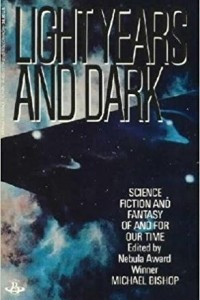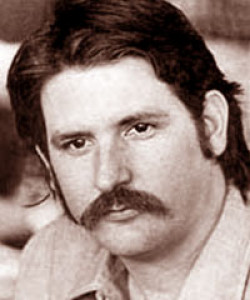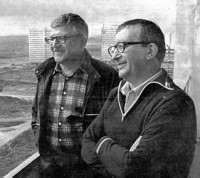-
Жанры
-
Художественная литература
- Приключения 75083
- Фантастика 100897
- Фэнтези 73474
- Детектив 59379
- Ужасы 48028
- Роман 70045
- Классическая литература 60314
- Историческая проза 8094
- Современная проза 141702
- Детская литература
- Культура и искусство
- Научная литература
- История
- Бизнес
- Прикладная литература
- Документальная литература
- Образование
- Дом и семья
- Физическая культура
- Здоровье
- Литература на иностранных языках
-
Художественная литература
- Книги
- Рецензии
- Сообщество
- Блоги
- Цитаты
- Тесты
- Подборки
- Премии
- Конкурсы
- Другое

Майкл Бишоп
Краткая биография автора
Michael Bishop is the son of Leotis ("Lee") Bishop (born 1920 in Fry's Mill, Arkansas) and Maxine ("Mac") Elaine Matison (born 1920 in Ashland, Nebraska). His parents met in the summer of 1942 when his father, a recent enlistee of the Air Force, was stationed in Lincoln, Nebraska. Bishop's childhood was the peripatetic life of a military brat. He went to kindergarten in Tokyo, Japan, and he spent his senior year of high school in Seville, Spain. His parents divorced in 1951, and Bishop spent sum...
Michael Bishop is the son of Leotis ("Lee") Bishop (born 1920 in Fry's Mill, Arkansas) and Maxine ("Mac") Elaine Matison (born 1920 in Ashland, Nebraska). His parents met in the summer of 1942 when his father, a recent enlistee of the Air Force, was stationed in Lincoln, Nebraska. Bishop's childhood was the peripatetic life of a military brat. He went to kindergarten in Tokyo, Japan, and he spent his senior year of high school in Seville, Spain. His parents divorced in 1951, and Bishop spent summers wherever his father happened to be based.Bishop entered the University of Georgia in 1963, receiving his bachelor's degree in 1967, before going on to complete a master's degree in English. In 1969, he married Jeri Ellis Whitaker of Columbus, Georgia. He taught English (including a course in science fiction) at the United States Air Force Academy Preparatory School in Colorado Springs from 1968 to 1972. After his service career, he taught composition and English literature at the University of Georgia in Athens. A son, Jamie, was born in 1971, and a daughter, Stephanie was born in 1973. Bishop left teaching in 1974 to become a full-time writer. In those early years of freelance writing, he would occasionally work as a substitute teacher in the public schools and as a stringer for the Ledger-Enquirer in Columbus.In 1996, Bishop became writer-in-residence at LaGrange College located near his home (built in the 1890s) in Pine Mountain, Georgia. He has held this position ever since. Bishop teaches creative-writing courses and an occasional January interim-term course.He and Jeri, a counselor at Rosemont Elementary School, have two grandchildren, Annabel and Joel, by their daughter Stephanie. On April 16, 2007, their son Jamie, a Lecturer in German and I.T. Studies, was one of the victims of the Virginia Tech massacre.Career overviewEarly work Michael Bishop's first published professional fiction sale was the short story "Piñon Fall" to Galaxy Science Fiction in 1970. It was shortly followed by "If a Flower Could Eclipse", the first story in his UrNu sequence (which is the only series of related stories in Bishop's career). While Galaxy Science Fiction and If magazines were publishing his sf stories, the Magazine of Fantasy and Science Fiction became Bishop's venue for his slightly off-kilter fantasy/horror stories. This early period is also noted for a number of high profile novellas: in 1973 "Death and Designation Among the Asadi" and "The White Otters of Childhood" appeared on the shortlist ballots for both the Hugo and Nebula awards. The 1974 gonzo novella "On the Street of the Serpents" (including a character named "Michael Bishop") first appeared in an anthology of original stories. It would eventually lead to a contract for his first novel from Ballantine Books, the anthology's publisher.Anthropological novelsSix of Bishop's first eight novels are set on other worlds (the other two are the part of his UrNu sequence of stories.) Critic and author John Clute writes that "…his early stories and novels display considerable intellectual complexity, and do not shirk the downbeat implications of their anthropological treatment of aliens and alienating milieux…" In his major essay on these early novels, author Ian Watson writes "Michael Bishop is both an exoticist and a moralist. He is sometimes guilty, in the first respect, of a certain over-writing – underlying exotic venue by exotic diction – though the two become more organically integrated as his work progresses; and in the second respect of what one might call an over-scrupulousness on the part of his characters and his perceived attitude to them… These, however, are merely the consequence of aspiration and conscience; and as more of Bishop's work has appeared – and his reputation has grown – he has shown…a more coherent melding of exotic vision, ethics and style."A Funeral for the Eyes of FireWhen Bishop's first novel, A Funeral for the Eyes of Fire, was published by Ballantine Books in 1975, critics Alexei and Cory Panshin wrote that the novel "shows an interest in the anthropological comparable to Ursula K. Le Guin and a sense of the alien comparable to James Tiptree, Jr. But it is an individual work, Bishop's own and no one else's. A Funeral for the Eyes of Fire is highly imperfect. It is a pied mirror, everywhere reflecting brilliantly bright, everywhere cloudy. It leads the eyes inward, and ultimately reveals nothing clearly. Even so, it is the most impressive first novel so far seen in the Seventies." They go on to declare that "Bishop is one of the new and still rare breed of science fiction writer attempting to produce art without rejecting the pulp vigor that is science fiction's continuing strengths." The novel was nominated for a Nebula Award in 1975.And Strange At Ecbatan The Trees Bishop's second novel (and first hardcover publication) takes its title from Archibald MacLeish's poem "You, Andrew Marvell". Published by Harper & Row in 1976, it is set in the same far future as his Hugo- and Nebula-nominated novella "The White Otters of Childhood." There are two surviving races, both genetically engineered by a third, the Parfects, who also manipulate the ongoing struggle between them. Richard A. Lupoff praised the novel lavishly, calling it "An eccentric, accomplished performance; and impressive and admirable one . . . a delightful book, a new treatment of a somewhat familiar theme, but crafted into a strange shape and told with such fineness of presence and such impressive language that it hardly matters what the book is about."Reviewer Keith L. Justice writes "If Bishop never published another word of fiction, he would still have to be considered a milestone writer in the development of contemporary sf… Writers such as Le Guin, Tiptree, and Bishop are developing a whole new generation of artistry."Stolen FacesIn Stolen Faces (published by Harper & Row in 1977), a recently demoted commissioner has been reassigned to a colony planet to govern a compound which isolates the sufferers of a leprosy-like disease. Ian Watson writes that the novel is "about deceit, maskedness and discovery of self-truth…a harsh, arctic tale by contrast with [And Strange At Ecbatan The Trees] where the terrain may be stark but there is a mannered elegance in the tone of voice; it is a tale executed in an argot-ritualistic style." Critic Richard Delap writes "There is an abundance of exploitable elements in Bishop's story, so it is astonishing to see how the author keeps them under strict rein, always with a highly keyed visual sense but also with a literary flair that says more by implication than by direct description. The writing itself is crafted with a precision that becomes obvious only as the novel progresses."Transfigurations The Hugo- and Nebula-nominated novella "Death and Designation Among the Asadi" forms the first part of Transfigurations, a novel published in 1979 by Berkley Putnam. The story continues when the daughter of the anthropologist who studied the Asadi, a hominid-like race on the planet Bosk'veld, investigates his disappearance. In the journal Foundation, John Clute writes that the novel is "a fever of explanation. Hypothesis builds on hypothesis [as more and more data is added to the original observations], and much of the resulting construction is beautifully crafted, almost hallucinatory it is so plausible. But of course these explanations are never enough – and the intellectual tact by which Bishop makes them almost but not quite fit the data they are meant to make transparent is perhaps the strongest part of this extremely dense and carefully thought-through novel." Legendary science fiction writer Theodore Sturgeon writes "Michael Bishop's Transfigurations is as complex, as carefully thought-out, and as compelling an sf novel as you'll find anywhere, ever." Transfigurations was nominated for the British Science Fiction Association Award in 1980. Eyes of FireIn 1980, Bishop was given the unusual opportunity by editor David Hartwell to rewrite his first novel. This completely revised version (or, as Bishop has called it, wholesale reimagining) was published by Pocket Books as Eyes of Fire. In his introduction to the British hardcover edition of the revised work, Bishop writes "…I still feel affection for the original version of A Funeral for the Eyes of Fire, its callow narrator, and a few of the flavorful images and metaphors with which I salted the text. But I also recognize the fumble-fingeredness and immaturity of that initial version." Very few publications (mostly fanzines) took enough notice to review the new version. (Pocket Books even used the artwork of the original publisher's edition.) In one of the rare reviews, Robert Frazier writes "In almost every detail, Eyes of Fire is crafted intelligently… It is not the type of sf that pushes to the heights of wonder. Instead it is a probing, disturbing, moving reflection on humanity… Bishop's skill is at plumbing to the depths, and his basic tool is a two-way glass. [Other novels this year] will have to go a long distance to surpass this effort."Under Heaven's BridgeWhen British author Ian Watson read Bishop's A Little Knowledge (1977), he was so fascinated with the alien Cygnusians that he wrote to inquire whether Bishop had plans to write a story about the aliens' home planet. Thus began what Bishop calls "the first ever transatlantic science fiction collaboration", with all correspondence sent by post. Although often labeled as the third book in the series, it is not truly part of the main UrNu sequence. In this novel, published in the UK by Gollancz (1981) and in the US by Ace Books (1982), a Japanese linguist, crewmember of the research starship Heavensbridge, arrives on the home planet of the Kybers (so-called because they're seemingly made of flesh and metal.) She soon learns that the planet's sun will shortly go nova. Brian Stableford writes that the novel when compared with other recent sf collaborations "is a very solid and rewarding piece of work. Its basic premise is original and intelligently worked-out, and the storyline sustains the fascination of the reader throughout. Nevertheless, it seems to me to fall slightly behind the standard set by recent solo works by either of the two authors." He concludes that the "book is worth reading, but it is not an outstanding work in either author's canon." This is Michael Bishop's last novel-length work of other worlds fiction.UrNu sequenceWith "If a Flower Could Eclipse" (1970), his second published story, Bishop began a series of stories set in the Urban Nucleus of Atlanta, one of several domed cities in his future history. Over the next decade he would write seven stories of varying length and one novel to fill in the century-long chronology. Some of the stories first appeared in such prestigious anthology series as Damon Knight's Orbit and Terry Carr's Universe. Four of the stories would subsequently be chosen for best-of-the-year anthologies. (N.B.: According to the author's website A Funeral for the Eyes of Fire and Under Heaven's Bridge are only tangentially connected to the series and thus not part of the sequence proper.) A Little KnowledgeThe only novel-length work in the UrNu sequence, A Little Knowledge, was published in 1977 by Berkley Putnam. Chronologically, its events fall just before the last story in the series, "Death Rehearsals". The alien Cygnusians that first appeared in the novella "Allegiances" have been brought into the domed city of Atlanta, causing quite a stir when one of them converts to the state sponsored religion. Mary S. Weinkauf writes "…this is a cleverly done book with many elements of previously admired sf…although it is maneuvered by too carefully contrived coincidences and leaves some questions at the end… [It] is a book to think about long after you put it down." Richard Delap writes that "characters…scurry through this shifting maze as if they are buffeted by the social and political activities of this future world rather than by an author plotting to reach a predestined conclusion. A Little Knowledge is a lively, thought-provoking novel that will exercise your brain."Catacomb YearsAll of the previously published stories in Bishop's UrNu sequence, along with a new novella, "Death Rehearsals", are contained in Catacomb Years, a fix-up published in 1979 by Berkley Putnam. Bishop also wrote new connecting material and provided a timeline. Spider Robinson's comments on the book's structure: "Plainly [Bishop] intended the Domed City to be a metaphor for something or other…and it probably worked just fine in some of those individual novelettes, where an emotionally involving story made you overlook a shaky premise. But the "novel" has no emotional continuity… There are a few marvelous stories in this book, and one superb one ["The Samurai and the Willows"], but they are ruined by a setting which exposes their worst weaknesses." Robert Frazier strongly disagrees: "Catacomb Years is not a rough sculpture with visible seams and weak welds; it is a polished puzzle entity a la Miguel Berrocal." Author Elizabeth Lynn was equally impressed: "Bishop takes his wildly diverse plot elements…and weaves them into a shining and almost seamless tapestry… The material, to those who have read the pieces as they appeared…will be familiar and friendly. But set against each other they acquire new significance and a new luster. Bishop's skill at characterization is impressive, as is his ability to juggle his cast and his numerous subplots."Later novelsNo Enemy But TimeBishop's critically acclaimed novel, the Nebula Award winning No Enemy But Time, was published in 1982 by Simon & Schuster under David Hartwell's editorship and the Timescape imprint. John Clute writes that the novel "intensified the movement of [Bishop's] imagination to a local habitat, and for the first time introduced a protagonist of sufficient racial (and mental) complexity to carry a storyline immured in the particular and haunted by the exotic." In this sophisticated twist on the traditional time-travel story, a modern day African-American man is recruited by the military for his special ability to "dream" himself into the Pleistocene era where he becomes involved with a tribe of habilines. Thomas Disch writes "Bishop is determined to write about human goodness without resorting to the mock heroics of formula adventure stories. There are no villains in the book, even among the habilines. The central and absorbing drama of the book is the hero's growing love for the habiline, Helen. Looming behind this love story is a larger theme, the formation across the entire span of history of the Family of Man, a phrase that becomes, as the novel ripens to its conclusion, no mere liberal piety but a fully realized dramatic affirmation." In one of the few mixed reviews, Tom Easton writes that "Kampa [the protagonist] is the only character who does come alive. All others are at least stiff. Some are outright caricatures. The book is not faultless, but it is overall a pleasure to read… Its treatment of anthropology is so effective that the few flaws are easily overlooked." Editor and critic David Pringle writes that the novel "is narrated in an oddly detached, quizzical and dryly humorous manner… The paleo-anthropological details are superbly imagined, the African landscapes beautifully described, yet the final effect is one of coolness, distance… Michael Bishop's prose style is learned, witty, Latinate, although salted with deliberately-placed colloquialisms and low jokes. This book is the work of a talented and serious writer." In addition to winning the Nebula Award, the novel was nominated for both the John W. Campbell Memorial and British Science Fiction Awards.Who Made Stevie Crye? Bishop followed-up his award-winning science fiction novel with a contemporary novel set in the rural American South. Mary Stevenson ("Stevie") Crye is a young widow with two children struggling to take care of her family as a freelance writer. Her typewriter has started to act up, automatically transcribing her nightmares and subsequently her future. The only American edition of Who Made Stevie Crye? was published in 1984 by the highly esteemed specialty publisher Arkham House under the editorship of Jim Turner. This original edition, as well as the British edition, was photographically illustrated by J. K. Potter. When David Pringle chose it for inclusion in his book Modern Fantasy: The Hundred Best Novels, he described the novel as "a playful metafiction about the real and the fictitious, about the writer and his or her creation…" and concluded that the novel is "…a gripping and intelligent tale of the supernatural by an author who is adept at avoiding most of the clichés of the horror genre." In his mixed review of the novel, Joe Sanders writes "Sometimes vivid, sometimes prosaic; sometimes involving but often affectless, this is not a novel to like casually. Even when it looks like standard mass-produced pop lit, it actually is nudging us toward something more disturbing and hilarious than we're comfortable imagining. It finally is impressive enough to be uneasily recommended." Sanders' editor, Robert A. Collins, chides the reviewer with the footnote "Ignore Sanders' uneasiness, which obviously stems from his difficulty in pegging the book's genre; Stevie Crye is a marvelous book which transcends genre, as all the best of Bishop does." Author Ian Watson writes "Here is a humane, trickster kaleidoscope questioning a genre and a market, and fiction, and reality too – yet exquisitely spiced with human reality – and delivering the eerie chill of the occult and the illicit, curdling the blood but also warming the heart."Ancient of DaysBishop's 1983 Locus Award-winning novella "Her Habiline Husband" forms the first third of Ancient of Days, published in 1985 by Arbor House. It's the story of "Adam", one of the last surviving Homo habilis who is discovered in contemporary Georgia. In this thematic companion to his novel No Enemy But Time (with an almost inverse conceit), Bishop tackles issues of racial and cultural prejudice, and explores the question of what it means to be human. Locus reviewer Debbie Notkin writes "This is science fiction so precise and so well-thought-out that it reads like history, although little history is so well-written, or cares so much about its characters." Bernard Goodman of Fantasy Review believes that "Bishop's theme of evil inherent in humanity echoes William Golding," and that the novel "in some ways…parallels Golding's Lord of the Flies." Ancient of Days was nominated for the Arthur C. Clarke Award in 1988.Philip K. Dick is Dead, AlasOriginally published as The Secret Ascension by Tor Books in 1987 (but subsequently reprinted with the author's preferred title), this work is an homage to writer Philip K. Dick, a pastiche of his style, and includes an alternate reality version of Dick as a character. The novel is set in a world in which Richard Milrose Nixon, in his fourth term as president, holds fascistic control over America, and the science fiction works of Philip K. Dick remain unpublished, distributed underground as samizdat, while his realist fiction titles are the ones that are celebrated as masterpieces. Author and reviewer Orson Scott Card writes that "the climax is not just an inward epiphany for a character… The world changes in wonderful strange ways, and the audience can read the book passionately, with sweating fingers, eager to see what happens next, yet reluctant to leave the present moment. Imagine: A writer who is already one of the best, taking risks and finding ways to be better." Card does take Bishop to task for the author's characterization of Richard Nixon, calling it a "caricature" and a "stock character of a madman." Locus reviewer Tom Whitmore calls the book "a masterful pastiche" and "…the closest thing to a classic Dick sf novel anyone has ever done." Gerald Jonas in the New York Times writes "Mr. Bishop is a solid, serious writer whose reach (in his previous work) has always seemed to me to exceed his grasp. Here, he catches some of Dick's fire, especially in the early chapters… Then a lot happens very quickly (as in some of Dick's own novels), and the satire, which should hold things together, turns predictable. But…the ending (starring Philip K. Dick) approaches sublimity." The novel was nominated for the Arthur C. Clarke Award in 1989.Unicorn MountainIn this novel, published by Arbor House/William Morrow in 1988, a man dying of AIDS is taken in by his cousin, a rancher in the Colorado mountains. Award-winning author Nancy Kress writes "Michael Bishop has pulled off a rare and amazing feat. Unicorn Mountain successfully weaves such traditional fantasy elements as unicorns and Indian lore together with the all-too-contemporary..." Orson Scott Card writes "The triumph of this, Bishop's most artistically whole and successful novel to date, is that he set out to do something that is nearly impossible in fiction: He wrote a novel about constructing a tribe...To do it, he had to bring us to know and understand and care about more fully-created characters than most writers produce in a career." John Clute's assessment emphasizes another theme of the work: "Michael Bishop, whose voice is like a shout from the bottom of the well of the enormous South, and whose heart is on his sleeve, [manages] in Unicorn Mountain to generate a moving tale out of ecological disaster here and in another world, AIDS, the death of cultures, the death of species, and the slow sea-changing of America into themeparks." The novel would go on to win the Mythopoeic Fantasy Award, and was shortlisted for the 1989 Locus Award.Count Geiger's BluesXavier Thaxton, protagonist of Count Geiger's Blues (subtitled "A Comedy"), is the fine arts editor for a newspaper in the fictional Southern metropolis of Salonika (a satirical/alternate reality version of contemporary Atlanta) with a particularly low opinion of pop culture. When he is accidentally exposed to illegally dumped nuclear waste, the radiation exposure turns him into a superhero (or, as Bishop has designated, a "stalwart"). Analog reviewer Tom Easton writes "This is where Bishop falters. The satire he has painstakingly created now teeters on the brink of farce. He quite properly makes the decision to yank it back from that brink, but then he loses the satire. He becomes heavy-handed and obvious." Faren Miller disagrees: "The most ambitious comic books are no longer merely comic – may even incorporate tragedy in a critique of modern life as savage and acute, in its way, as the ferocious satire of Dante's Inferno. Count Geiger's Blues also goes beyond humor – well beyond, in its remarkable closing chapters. But they build on all that has gone before. In unleashing a startling talent for comedy and a wide-ranging knowledge of pop culture in both its absurdity and its splendor, Michael Bishop has written his best book yet." John Kessel writes "Comedy is certainly a new tone from Bishop, and he demonstrates a talent for it…But it seems to me Bishop doesn't really want to write comedy. It's as if Bishop is running riffs on whatever wacky ideas come to hand, without much plan, holding his characters at arm's length; as if, trying to avoid sententiousness, he has to avoid caring – but in the end can't. The result being a loose, baggy sort of book."Brittle InningsBrittle Innings could for most intents and purposes be considered a sequel to Mary Shelley's Frankenstein. This simple designation only begins to describe this emotionally and creatively complex story. The novel, published in 1994 by Bantam Books, attempts to answer the questions: What if the doctor's much maligned creation managed to survive his Arctic pursuit? and How would he be perceived in modern times? Bishop places him in the American Deep South during World War II playing minor league baseball. Author and critic Brian Stableford writes that "no potential reader should allow himself or herself to be put off by the seeming freakishness of its premise… There is not a wasted image or phrase in the text, which is extraordinarily rich and eminently readable from beginning to end. It is a very fine book indeed…" Concerning its relationship to Shelley's novel, Stableford writes that "Brittle Innings seems to me to be the best sequel imaginable." The New York Times book reviewer felt uncomfortable with the mix: "The [baseball story] is the real reason to read Brittle Innings; it has a better narrative and a more meaningful message than the subplot about the literate and sometimes likable monster. Mr. Bishop's fine prose makes each of these plot lines well worth reading, but they belong in separate novels."In his essay "Of (Human) Bondage in Michael Bishop's Brittle Innings" Joe Sanders compares Bishop's young protagonist with Philip Carey of Somerset Maugham's Of Human Bondage. "Philip Carey's struggle toward maturity is painfully messy…unconsciously he knows what he needs: connection to and then freedom from parental authority so that he can determine his own goals in life. [Michael Bishop's] Danny Boles, with similar needs, is certain that he already has found something to believe in: baseball." Sanders concludes "Insofar as the characters of Brittle Innings learn to see life's vivid extremes and as they struggle to see more, they demonstrate that love can sometimes lead not to bondage but freedom." The novel won the Locus Award for Best Science Fiction Novel in 1995, and was nominated for the Hugo, World Fantasy, and Campbell Awards that same year.Selected short fictionIn his introduction to an interview with Michael Bishop, in a reference to Bishop's short story collections, Nick Gevers writes "These volumes, combining the sublimely exotic and the drawlingly familiar, satirical humour and timeless tragedy, constitute one of the finest short fiction oeuvres in SF's history.". Author, critic and sometime collaborator, Paul Di Filippo writes"Since his first short-story sale in 1970, Michael Bishop has revealed a questing spiritual intelligence uniquely concerned with moral conundrums. While his works are often full of both the widescreen spectacles associated with science fiction and the subtle frissons typical of more earthbound fantasy, his focus remains on the engagement of characters with ethical quandaries any reader might encounter in his or her daily life. . . While only occasionally delving into explicitly religious themes, Bishop's personal Christian faith—wide enough to embrace references to Buddhism, Sufism and other creeds—shines through in every tale. . . Acknowledged as one of the genre's finest and most meticulous short-story writers, Bishop boasts six collections to date that function as treasure troves of both science fiction and fantasy. (A seventh lives up to its title, Emphatically Not SF, Almost, by hosting only mainstream tales.) ""The Quickening", Bishop's Nebula Award winning novelette of 1981, is, according to Brian W. Aldiss and David Wingrove "…perhaps, a perfect modern fable. A fable about America and her values. For what is being torn down stone by stone is a world spoiled by the trite commercial values of American culture." It's the story of an ordinary American man who awakes to find himself in Seville, Spain. He soon discovers that the population of the whole world has been scattered, creating a potent stew of race, ethnicity, culture and language.A major theme throughout much of Bishop's work (and especially so in his short fiction) is the role of religion in the daily lives of human beings.When several readers wrote letters of protest to Isaac Asimov's Science Fiction Magazine about its 1983 publication of Bishop's novella "The Gospel According to Gamaliel Crucis," Isaac Asimov himself wrote an editorial defending the work and the editor's decision to publish it. He wrote "…we had a remarkable story that considered, quite fearlessly, an important idea, and we felt that most readers would recognize its legitimacy – if not at once, then upon mature reflection."When Bishop's story "Dogs' Lives" was reprinted in Best American Short Stories 1985, it became one of only a handful of genre stories to appear in the prestigious anthology series. The story might have languished in limbo, had the author not pulled its submission to Harlan Ellison's never-published anthology The Last Dangerous Visions.
На нашем книжном сайте Вы можете скачать книги автора Майкл Бишоп в самых разных форматах (epub, fb2, pdf, txt и многие другие). А так же читать книги онлайн и бесплатно на любом устройстве – iPad, iPhone, планшете под управлением Android, на любой специализированной читалке. Электронная библиотека КнигоГид предлагает литературу Майкл Бишоп в жанрах .
Творчество Майкл Бишоп
На нашем сайте представлены 11 книг автора Майкл Бишоп. Самая популярная по мнению наших читателей "".
Unicorns roam the uplands of Libby Quarrels' mountain ranch. When Libby takes the AIDS-afflicted Bo Gavin out of exile in Atlanta to live with her in Colorado, she sees no connection between his disease and the fantastic secret she guards. But it so happens the unicorns suffer from a plague of their own, and the alternate world that touches the high country has unleashed magic sinister as wel...
Сариела, ангел-хранитель семейной четы Хембри, настолько прониклась некоторыми человеческими желаниями, что это вызвало тревогу у архангела Рафаэля.
For Mary Stevenson Crye, a beautiful young housewife, life had been wonderful -- loving husband, two delightful children, meaningful existence in a small Southern community. Then it all fell apart: with the sudden, unexpected death of her husband, Stevie must struggle to earn a living as a freelance writer. When her typewriter -- the sole economic support for her surviving family -- breaks down, S...
Tells the stories of a mysterious astronaut, suspended animation, time travel, alien invasions, post nuclear societies, and alternate worlds.
Frankenstein meets Field of Dreams in this nostalgic, gracefully written but fundamentally flawed baseball novel. Set in a sleepy Georgia town during WW II, this coming-of-age saga is based on the real-life story of Danny Boles, a major league scout who died of throat cancer in 1989. The fictional Boles leaves his rural Oklahoma digs to become shortstop for the Hightower Hellbenders, vaulting the ...
Похожие авторы

Если у Вас возникли вопросы по работе сайта - напишите нам!
нашли ошибку на странице!

Нейросеть ориентируется на оценки прочитанных вами книг
поиск

Найдите книгу, автора, подборку, издательство, жанр, настроение или друга на Книгогид
подборки

Создавайте подборки с книгами, которые вы прочитали, подписывайтесь на подборки интересных пользователей.
Регистрируясь, вы соглашаетесь с нашими Условиями и политикой конфиденциальности
Книгогид использует cookie-файлы для того, чтобы сделать вашу работу с сайтом ещё более комфортной. Если Вы продолжаете пользоваться нашим сайтом, вы соглашаетесь на применение файлов cookie.















